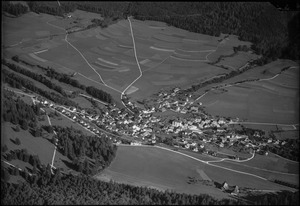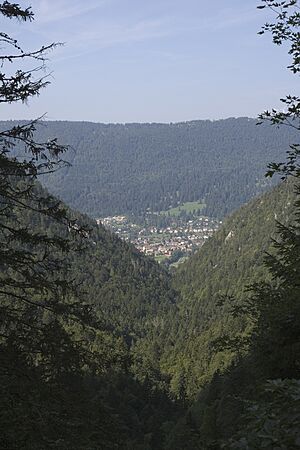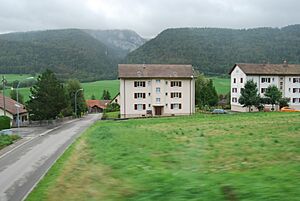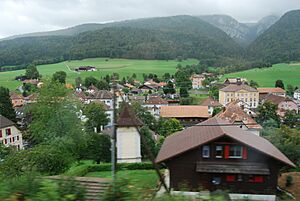Villeret, Switzerland facts for kids
Quick facts for kids
Villeret
|
||
|---|---|---|
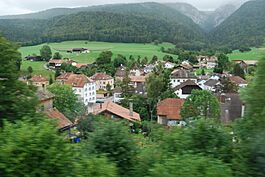 |
||
|
||
| Country | Switzerland | |
| Canton | Bern | |
| District | Jura bernois | |
| Area | ||
| • Total | 16.24 km2 (6.27 sq mi) | |
| Elevation | 740 m (2,430 ft) | |
| Population
(Dec 2020 )
|
||
| • Total | 941 | |
| • Density | 57.94/km2 (150.07/sq mi) | |
| Postal code |
2613
|
|
| Surrounded by | Saint-Imier, Nods, Cormoret, Les Breuleux, Muriaux, Villiers | |
| Twin towns | Louzac-Saint-André (France) | |
Villeret (pronounced vil-ray) is a charming town, also known as a municipality, located in the French-speaking part of Switzerland. It is nestled in the Bernese Jura area, within the Canton of Bern. Villeret is known for its beautiful natural surroundings and its interesting past.
Contents
Villeret's Journey Through Time
Villeret was first mentioned in official records way back in 1390. For many years, it was part of a larger territory called Erguel. This area was ruled by a powerful church leader known as the Prince-Bishop of Basel.
Changes in Control: From France to Switzerland
In 1797, after a big victory by the French army, Villeret became part of France. It was first in a French region called Mont-Terrible, then later in Haut-Rhin. But after Napoleon's defeat, Villeret joined the Canton of Bern in Switzerland in 1815. This was decided at a big meeting called the Congress of Vienna.
Nature and Community Development
A special nature reserve, Combe-Grède/Chasseral, was created in Villeret in 1932. This helps protect the beautiful local environment. The village was part of the Saint-Imier church community until 1951. Then, it became its own independent church parish. The local Reformed church was built between 1936 and 1937.
Villeret's Industrial Growth
In the mid-1700s, many workshops like forges, mills, and sawmills were built along the Suze river. The river's power attracted many skilled workers, including blacksmiths and locksmiths. In 1725, the famous watchmaking industry arrived in Villeret. Craftsmen started making tiny watch parts.
Big watchmaking families, like the Blancpain family, helped the town grow. They built houses and factories to attract more skilled workers. When the Biel-Les Convers railroad was finished in 1874, Villeret's population grew even more. It reached its highest point around 1910.
Challenges and Recovery in Industry
The watch industry faced tough times during financial crises in the 1930s and 1970s. However, it started to get better in 1993 when Cartier opened a factory in Villeret. In 2000, a factory for dental implants, Straumann, also opened. Sadly, Cartier closed its factory in 2003. Even so, by 2005, most jobs in Villeret were still in manufacturing.
Villeret's Natural Surroundings
Villeret covers an area of about 16.22 square kilometers. Almost half of this land, about 45.4%, is used for farming. Another large part, about 49.9%, is covered by forests. The rest of the land includes buildings, roads, and a small amount of rivers.
Most of the forested land is dense forest. A small part has orchards or groups of trees. The farmland is used for growing crops, pastures, and alpine pastures. All the water in Villeret comes from flowing rivers and streams. The town is located in the Bernese Jura region, right at the foot of Mount Chasseral.
Villeret's Coat of Arms
The official symbol, or coat of arms, of Villeret is described as: Gules on a Bend Argent three Trefoils downpointing Vert all within a Border Or. This means it has a red background with a silver stripe. On the stripe, there are three green clover-like shapes pointing downwards. All of this is surrounded by a gold border.
Who Lives in Villeret?
Villeret has a population of about 890 people. As of 2010, about 9.6% of the people living here were from other countries. Over the past ten years, the population has changed a little, mostly due to people moving in and out.
Languages Spoken in Villeret
Most people in Villeret speak French as their main language, about 83.1% of the population. German is the second most common language, spoken by about 11.3% of the people. Albanian is the third most common, spoken by about 2.4%. A few people also speak Italian or Romansh.
Population Breakdown by Age and Origin
As of 2008, about 49.5% of the population was male and 50.5% was female. Many people, about 24.1%, were born in Villeret and still lived there in 2000. About 32.9% were born in the same canton, and 23.9% were born elsewhere in Switzerland. About 13.3% were born outside Switzerland.
In 2010, children and teenagers (ages 0-19) made up about 21.1% of the population. Adults (ages 20-64) made up 58.9%, and seniors (over 64) made up 20.1%.
Living Arrangements and Housing
In 2000, there were 124 households where only one person lived. There were also 28 households with five or more people. Most apartments, about 84.5%, were lived in all the time. A small number were used only part of the year, and some were empty. In 2011, about 4% of the homes in Villeret were empty.
Villeret's Economy and Jobs
In 2011, Villeret had a low unemployment rate of 2.58%. This means most people who wanted to work had jobs. In 2008, there were 749 people working in Villeret.
Types of Jobs in Villeret
- Primary Sector: About 40 people worked in farming and related businesses.
- Secondary Sector: The largest group, 635 people, worked in manufacturing. This includes making things in factories, especially watches.
- Tertiary Sector: About 74 people worked in services. This includes jobs in shops, transportation, hotels, and education.
In 2008, there were 703 full-time equivalent jobs. Most of these, 607 jobs, were in manufacturing. Other jobs in the service sector included sales, transport, hotels, and education.
Commuting and Transportation
In 2000, more people came into Villeret for work than left to work elsewhere. About 12.9% of the workers coming into Villeret were from outside Switzerland. For getting to work, about 10.8% used public transportation, and 61.6% used a private car.
Religion in Villeret
Based on the 2000 census, about 17.8% of the people in Villeret were Roman Catholic. A larger group, about 47.9%, belonged to the Swiss Reformed Church. Some people belonged to other Christian churches, including Orthodox churches. About 4.11% of the population was Islamic. A very small number were Buddhist. About 19.31% of the people did not belong to any church.
Education in Villeret
Many adults in Villeret have a good education. About 35.3% have finished high school, and 12.9% have gone on to higher education, like university.
School System in Bern Canton
The Canton of Bern has a specific school system. It starts with one year of optional kindergarten. Then, students attend six years of primary school. After that, there are three years of lower secondary school. Students are grouped by their abilities. After secondary school, students can continue their education or start an apprenticeship.
Students and Libraries
During the 2010-11 school year, 95 students attended classes in Villeret. There was one kindergarten class with 17 students. The town had four primary classes with 78 students. Some students came from other towns to study in Villeret, and some Villeret residents went to schools outside the town.
Villeret also has a library called Bibliothèque communale et scolaire du Soleil. In 2008, it had over 6,000 books and other items. It loaned out 3,500 items that year. The library was open 160 days a year, for about 4 hours each week.
Getting Around Villeret
Villeret has its own railway station. It is located on the train line that connects Biel/Bienne and La Chaux-de-Fonds. Trains run every hour, making it easy to travel to these nearby towns.
Images for kids
See also
 In Spanish: Villeret (Berna) para niños
In Spanish: Villeret (Berna) para niños






